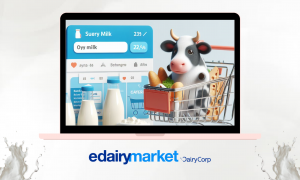
Milk has always been present in our lives, it is a crucial element since we all need it for a good somatic functioning. And it is also an element that connects us all, since we all go through the infant stage. Milk production is what defines us as mammals.
The class Mammalia, to which we humans belong, is defined by having breasts. According to the type of milk, the concentration of lipids, proteins and lactose it contains varies. The human baby consumes milk with 4.5 percent fat, 1.1 percent protein, 6.8 percent lactose and 87 percent water.
Lactose, the milk sugar, is only digestible when lactase, an enzyme, is present in the intestines. Almost all of us are born with lactase; without it, the baby would not be able to feed from the mother’s breast.
It is ironic that lactose intolerance is a natural condition of all adult mammals, and that we humans are the only ones who continue to consume milk after weaning. The young of other mammals suckle only until they are able to consume other food, at which point a gene is activated that affects their ability to digest milk.
In humans, however, milk intake has a long history:
Its historical origin dates back to 4,000 BC, which gave rise to one of the world’s first civilizations: the Sumerians. This people developed agricultural and livestock systems. It was the first time there are records of milk consumption.
The Greeks were not left behind in the dairy culture either, since in “Homer’s Odyssey” we read: “They were orphaned in the palace, but the divine Aphrodite fed them with cheese and sweet honey and delicious wine”.
In addition, dairy products had a divine connotation, which is why Hippocrates used milk as an antidote against poisoning.
In history there are also a lot of legends, such as that of Romulus and Remus, suckled by a she-wolf. According to Roman tradition, the she-wolf took them in as their foster mother after their abandonment, until they were adopted again by a shepherd who raised them with his wife.
In the Middle Ages, monks were already in charge of cheese production. In the 15th century, in Switzerland, important markets began to emerge, being the first to develop the dairy industry in Europe.
Raw milk is a product that is easily altered at room temperature, which is why consumption was so low in the Middle Ages, preferring the consumption of cheese (a less perishable food).
As we have seen, milk has gone through a lot of processes and stages. It has always been part of our history, and will continue to be so.
Taking advantage of this journey through the history of milk, we invite you to be part of the largest international dairy catalog in the world at eDairy Market. That way you can continue to spread this story and continue to communicate its importance.
In eDairy Market you will be able to sell and buy all dairy products (Products, Ingredients) and know the prices of the sector in all its categories (Machinery, Services, Animal Nutrition).
What are you and your company waiting for to be part of eDairy Market?
Sources:























